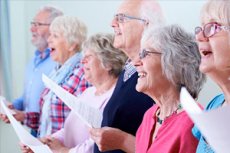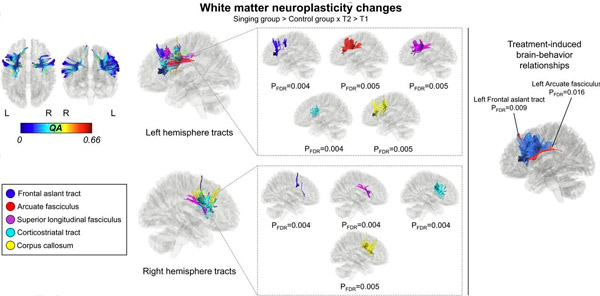
脑血管疾病(又称中风)是失语症(一种由脑损伤引起的语言障碍)最常见的病因。失语症患者难以理解或表达言语或书面语言。据估计,约有40%的中风患者患有失语症。其中一半患者即使在初次发病一年后仍会出现失语症的症状。
此前,赫尔辛基大学的研究人员发现唱歌有助于中风患者恢复说话能力。现在他们找到了唱歌康复效果的原因。这项最近完成的研究发表在《eNeuro》杂志上。
研究结果表明,唱歌可以修复大脑的结构性语言网络。语言网络负责处理我们大脑中的语言和言语。对于失语症患者来说,这个网络受到了损伤。
赫尔辛基大学研究员阿列基·西沃宁 (Aleki Sihvonen) 表示:“我们的研究结果首次证明,通过唱歌对失语症患者进行康复治疗是基于神经可塑性,即大脑的可塑性。”
唱歌可以改善语言网络通路
语言网络包括参与处理语言和言语的大脑皮层区域,以及在大脑皮层不同区域之间传递信息的白质。
根据这项研究,唱歌可以增加左额叶语言区域的灰质体积,改善大脑束连通性,尤其是左半球的语言网络,但对右半球也有帮助。
Sihvonen 表示:“这些积极的变化与患者言语表达能力的改善有关。”

治疗引起的白质神经可塑性变化。连接测量结果显示,在T1和T2之间,与对照组相比,唱歌组显著增加的神经束节段(ΔT2–T1;左图),且纵向QA变化与命名能力提高存在相关性(右图)。来源:eneuro (2024)。DOI:10.1523/ENEURO.0408-23.2024
共有54名失语症患者参与了这项研究,其中28名患者在研究开始和结束时接受了核磁共振扫描。研究人员通过合唱、音乐疗法和家庭唱歌练习,考察了唱歌的康复效果。
唱歌作为一种经济有效的治疗方法失语症对患者的功能能力和生活质量有广泛的影响,并容易导致社会孤立。
Sihvonen 认为,唱歌可以被视为传统康复形式的一种经济有效的补充,或者在其他康复形式有限的情况下作为轻度言语障碍的康复方法。
“患者还可以与家人一起唱歌,而且可以在医疗保健环境中组织集体唱歌,这是一种经济有效的康复方式,”Sihvonen 说。

